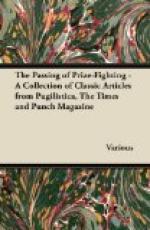Mr. ELLIOT is excellent as the Hon. Montague Trimble; nothing better, apart from Mr. HARE’s eccentric characters, has been seen on the stage for some considerable time. I hope the author is of the same opinion. Mr. FRED THORNE is capital as the Irish Member; and as Mrs. Hooley, an obtrusively Irish eccentricity of Thackerayan extraction, Miss ALEXES LEIGHTON is very good, for the character, as drawn by the author, is obtrusive, and is so meant to be. The Mrs. Egerton Bompas of Miss FANNY BROUGH is the woman to the life, and, in my humble judgment, Miss BROUGH’s impersonation is well-nigh faultless. Whether, if the part of Egerton Bompas were played as high comedy, this would still improve Miss BROUGH’s impersonation of Mrs. Bompas or not, it is difficult to decide; but I am inclined to think this would be the result. What does the author think? Most likely he will continue to “think”; it is the wiser course. Mr. HENRY V. ESMOND makes the lad, Howard Bompas, unnecessarily repulsive; but if, in doing so, he is only exactly carrying out the author’s idea, i.e., “Master’s orders,” then he is no longer responsible for the overcharged colouring. The probable fate of this unhappy pair, an impulsive uneducated kind of Irish orange-girl married to a contemptible young sot, is not a pleasant termination to the story, nor is the anticipatory sadness felt for the future of this ill-assorted couple in any way dissipated by the stereotyped and perfunctory offer of marriage made by the young London Journal Nobleman to the daughter of the utterly crushed snob just before the Curtain descends.
Why the piece is called The Times, remains a mystery. To-day would have been better; that is, if by The Times is only meant “The Present Day.” And if it doesn’t mean this, what meaning has it? For alliterative advertisement it may be useful; e.g., “Times at TERRY’s.” The dialogue generally is easy, natural and telling.
Yours,
PRIVATE BOX.
* * * * *
FOLLOW THE BARON!
["Such characters as he should
retire into fiction, they
are too exaggerated for real
life.”—"Times” on Mr. R.L.
Stevenson’s Sad Maron
of Samou.]




